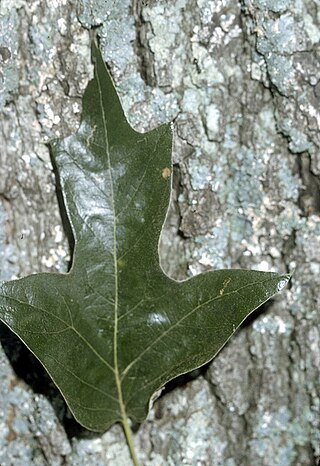
Quercus falcata, also called southern red oak, spanish oak, bottomland red oak or three-lobed red oak is an oak. Native to the southeastern United States, it gets its name the "Spanish Oak" as these are the areas of early Spanish colonies, whilst "southern red oak" comes from both its range and leaf color during late summer and fall. The southern red oak is a deciduous angiosperm, so has leaves that die after each growing period and come back in the next period of growth.

Quercus engelmannii, the Engelmann oak or Pasadena oak, is a species of oak in the white oak section, native to southern California and northwestern Baja California, Mexico.
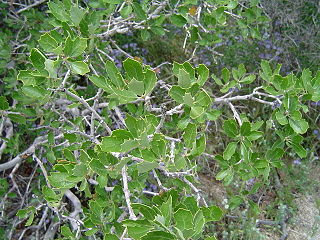
Quercus berberidifolia, the California scrub oak, is a small evergreen or semi-evergreen shrubby oak in the white oak section of Quercus. It is a native of the scrubby hills of California, and is a common member of chaparral ecosystems.

Quercus lyrata, the overcup oak, is an oak in the white oak group. The common name, overcup oak, refers to its acorns that are mostly enclosed within the acorn cup. It is native to lowland wetlands in the eastern and south-central United States, in all the coastal states from New Jersey to Texas, inland as far as Oklahoma, Missouri, and Illinois. There are historical reports of it growing in Iowa, but the species appears to have been extirpated there. It is a slow-growing tree that often takes 25 to 30 years to mature. It has an estimated lifespan of 400 years.

Quercus benthamii is a species of oak in the family Fagaceae. It is native to the cloud forests of Central America and southern Mexico. It is threatened by habitat loss.
Quercus deliquescens is a species of oak tree in the family Fagaceae, native to northeast Mexico. It is placed in section Quercus.

Quercus devia is a species of oak tree in the family Fagaceae, native to northwestern Mexico. The tree is endemic to the Sierra de la Laguna range of the Peninsular Ranges system, located in the southern part of the Mexican state of Baja California Sur. It grows in Sierra de la Laguna pine-oak forests habitats. It is an IUCN Red List endangered species, threatened by habitat loss. It is placed in section Lobatae.
Quercus galeanensis is a species of oak tree in the family Fagaceae, native to Northeastern Mexico. The tree is endemic to Mexico, restricted to two subpopulations occupying a narrow band from Galeana in Nuevo León state, to the Miquihuana region in Tamaulipas state. It is an IUCN Red List endangered species, threatened by habitat loss. It is placed in section Lobatae.

Quercus germana, the Mexican royal oak, is a species of oak tree in the family Fagaceae. It is native to mountain cloud forests in eastern Mexico. It is placed in section Quercus.

Quercus miquihuanensis is a species of oak in the family Fagaceae. It is endemic to the Nuevo León and Tamaulipas states of Mexico. It is an endangered species, threatened by habitat loss. It is placed in section Lobatae.
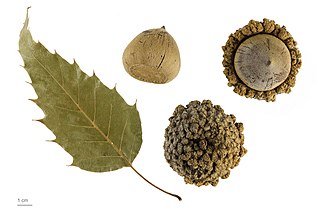
Quercus skinneri is a species of oak. It is found in Mexico, Guatemala, Honduras, and El Salvador. It is threatened by habitat loss.
Quercus vicentensis is a species of oak tree in the family Fagaceae, native to southern Mexico and northern Central America. It is placed in section Quercus.

The Trans-Mexican Volcanic Belt pine–oak forests is a subtropical coniferous forest ecoregion of the Trans-Mexican Volcanic Belt of central Mexico.
Quercus hinckleyi, commonly called Hinckley oak, is a rare species in the white oak group. It has a restricted range in the Chihuahuan Desert of the southwestern United States and northern Mexico. In the US, it occurs in only two counties in southwestern Texas and is federally listed as a threatened species.
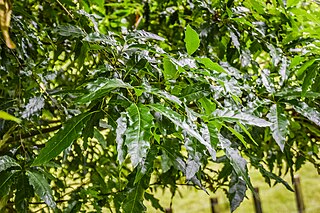
Quercus canbyi, synonyms including Quercus graciliformis, is a North American species of oak tree.
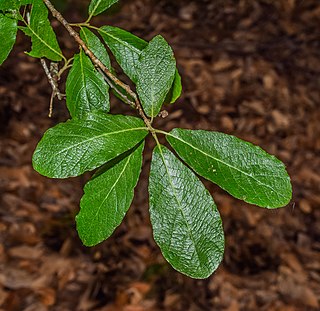
Quercus sideroxyla, called the Santa Rosa oak and encino colorado, is a species of oak native to northern and southwestern Mexico. Used for charcoal production, it prefers to grow at elevations from 1,800 to 2,700 metres. It is placed in section Lobatae.

Quercus crispipilis is a species of oak native to Chiapas state in southern Mexico and to Guatemala.
Quercus nixoniana is an endangered species of oak tree native to southern Mexico. It is found in humid mountain forests of southwestern Mexico, in the states of Jalisco, Guerrero, and Oaxaca.
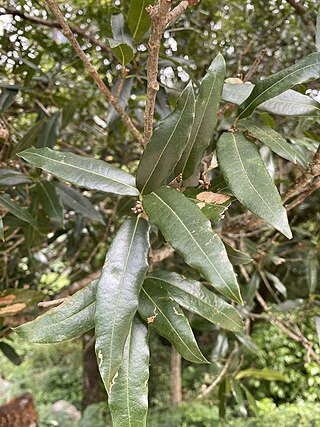
Quercus pinnativenulosa is a species of oak endemic to Mexico.
Quercus furfuracea is a species of oak native to eastern Mexico.















